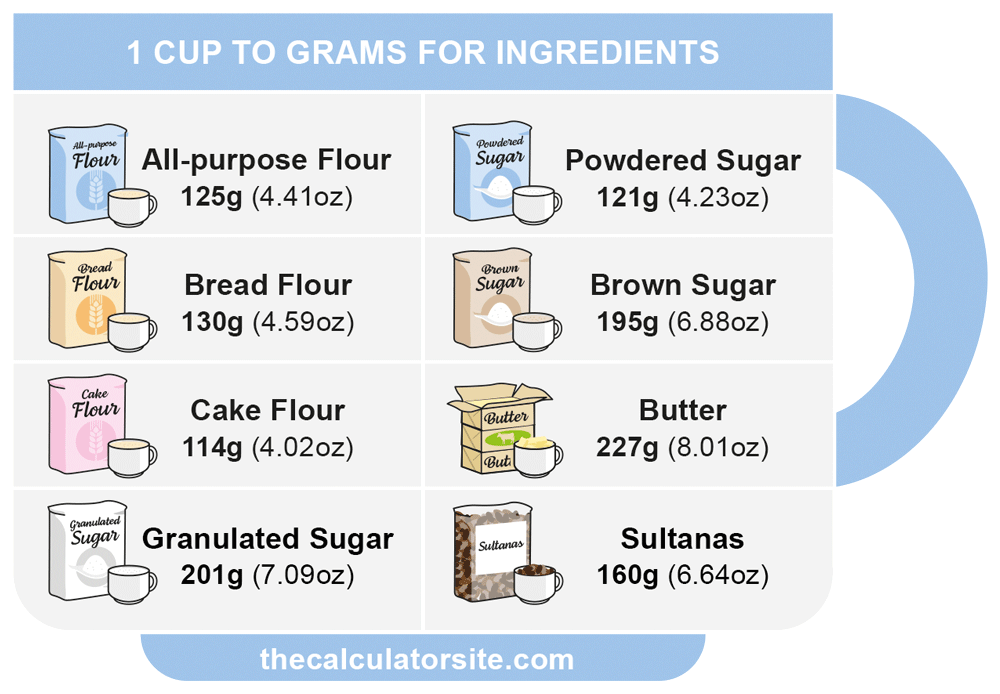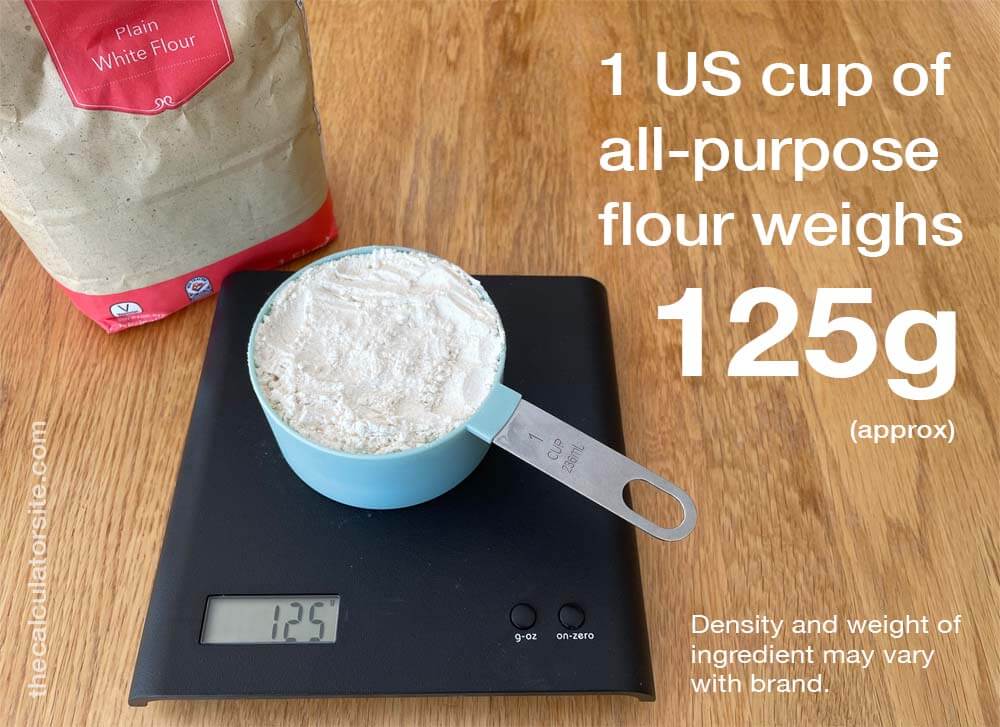Cups to Grams Converter
- Cups to Grams
- Grams to Cups
- mL to Grams
Find out how many grams there are in a cup of flour, sugar, butter or other baking or cooking ingredient. Want an ingredient added to our list? Please get in touch.
Disclaimer: Whilst every effort has been made in building our calculator tools, we are not to be held liable for any damages or monetary losses arising out of or in connection with their use. Full disclaimer.
How many grams are in a cup?
The number of grams in one cup is dependent upon the ingredient, due to differing ingredient density. For flour, 1 cup equates to around 125g. For sugar, 1 cup measures around 200g. For butter, 1 cup equates to around 227g.

Common cup to gram conversions
Bakers need to stick together. So, we're providing you with some cup to gram conversions for common ingredients, which you can find below. These conversions reference the standard US cup (236.588ml) and assume that your ingredient is being spooned into the cup (your cup may contain 15% more flour if using 'dip and sweep'). Note that we've also included measurements for cups to ounces, for good measure (pun intended).
| Ingredient | Grams | Ounces |
|---|---|---|
| All-purpose flour | 1 cup = 125 g | 4.4 oz |
| Bread flour | 1 cup = 130 g | 4.6 oz |
| Cake flour | 1 cup = 114 g | 4 oz |
| Butter | 1 cup = 227 g | 8 oz |
| Granulated sugar | 1 cup = 201 g | 7.1 oz |
| Powdered sugar | 1 cup = 121 g | 4.2 oz |
| Brown sugar | 1 cup = 195 g | 6.9 oz |
| Sultanas | 1 cup = 160 g | 6.6 oz |
US and UK cup sizes
Are you a 'cup half-full' or a 'cup half-empty' kind of person? Hopefully, you're the former, because it's going to take some patience, hope and determination to get to grips with the concept that is cooking with measuring cups.
In the UK, cups have rarely been used in recipes since the 1960s. If it's an old UK recipe, it'll use the imperial cup (284.131ml), which is significantly more than its more modern 250ml metric cup counterpart, now referenced in the UK as well as Australia, New Zealand, Canada and the rest of the Commonwealth.
In the US, it's 236.59ml in recipes, but 240ml on nutritional labelling. Still with me? The mess begins before you've even cracked an egg.
With all this confusion around cup sizes, weighing in grams with a set of kitchen scales becomes an easier and more accurate way to cook. It also helps you ensure your cake doesn't turn out somewhere between a concrete slab and a chocolate omelette. After all, depending what country your cups are from, how tightly you pack the ingredient in, and whether the top is heaped or levelled, baking can become a bit of a roulette game. And cake is not something to be messed around with. Not on my watch, brother.
How to convert cups to grams
Let's look at how to convert a cup measurement to grams to get you a Bake Off-worthy cake.
To calculate the grams from a recipe given in cups, it's vitally important to consider what the ingredient is. A cup of ball-bearings will weigh much more than a cup of feathers (though both make for delicious pancake toppings, my toothless cousin tells me). Therefore, there's no single gram equivalent for a cup; salt can be as heavy as 300g, while fresh breadcrumbs would only come to 60g. It all comes down to the density of the ingredient.
To convert cups to grams, multiply your cups figure by 236.588 and again by the ingredient density (in g/ml). If your density is not in g/ml, you will need to convert your density figure first.
Let's look at an example of how to convert cups to grams (using a US cup).
Example: Mabel is baking a Victoria Sponge cake and wants to convert 3 cups of all-purpose flour to grams. She finds that her all-purpose flour has a density of 0.529 g/cm³. Her calculation is therefore as follows:
3 × 236.588 × 0.529 = 375.5 grams.
You can use the reference tables below to assist you with converting your recipe ingredients from 1/4, 1/2, 3/4 cups to grams, or vice-versa. Note that we also have other tools to help you convert grams to tablespoons, teaspoons and milliliters.
Weighing scales at the ready, let's go through the most common baking ingredients in turn...
How much is 1 cup of sugar in grams?
One cup of granulated sugar measures around 200 grams or 7.1 ounces. One cup of powdered sugar weighs around 121 grams or 4.2 ounces.
| Cups | Grams | Ounces |
|---|---|---|
| 1/4 cup | 50 g | 1.8 oz |
| 1/3 cup | 67 g | 2.4 oz |
| 1/2 cup | 101 g | 3.5 oz |
| 2/3 cup | 134 g | 4.7 oz |
| 3/4 cup | 151 g | 5.3 oz |
| 1 cup | 201 g | 7.1 oz |
How much is 1 cup of butter in grams?
One cup of butter measures around 227 grams or 8 ounces. Half a cup of butter weighs around 114 grams or 4 ounces.
| Cups | Grams | Ounces |
|---|---|---|
| 1/4 cup | 57 g | 2 oz |
| 1/3 cup | 76 g | 2.7 oz |
| 1/2 cup | 114 g | 4 oz |
| 2/3 cup | 151 g | 5.3 oz |
| 3/4 cup | 170 g | 6 oz |
| 1 cup | 227 g | 8 oz |
How much is 1 cup of flour in grams?
One cup of all-purpose flour measures around 125 grams or 4.4 ounces. One cup of bread flour weighs around 130 grams or 4.6 ounces.

| Cups | Grams | Ounces |
|---|---|---|
| 1/8 cup (2 tbsp) | 16 g | 0.6 oz |
| 1/4 cup | 31 g | 1.1 oz |
| 1/3 cup | 42 g | 1.5 oz |
| 1/2 cup | 63 g | 2.2 oz |
| 2/3 cup | 83 g | 2.9 oz |
| 3/4 cup | 94 g | 3.3 oz |
| 1 cup | 125 g | 4.4 oz |
| Cups | Grams | Ounces |
|---|---|---|
| 1/4 cup | 33 g | 1.1 oz |
| 1/3 cup | 43 g | 1.5 oz |
| 1/2 cup | 65 g | 2.3 oz |
| 2/3 cup | 87 g | 3.1 oz |
| 3/4 cup | 98 g | 3.4 oz |
| 1 cup | 130 g | 4.6 oz |
| Cups | Grams | Ounces |
|---|---|---|
| 1/8 cup (2 tbsp) | 16 g | 0.6 oz |
| 1/4 cup | 32 g | 1.1 oz |
| 1/3 cup | 42 g | 1.5 oz |
| 1/2 cup | 64 g | 2.2 oz |
| 2/3 cup | 85 g | 3 oz |
| 3/4 cup | 95 g | 3.4 oz |
| 1 cup | 127 g | 4.5 oz |
Other baking ingredients
| Ingredient | 1 Cup | 1/2 Cup | 1/3 Cup |
|---|---|---|---|
| Cake flour | 114 g | 72 g | 38 g |
| Honey | 336 g | 167 g | 112 g |
| Margarine | 230 g | 115 g | 76.6 g |
| Milk | 244.87 g | 122.44 g | 81.62 g |
| Oats | 102.2 g | 51.1 g | 34.1 g |
| Rice (uncooked) | 178.15 g | 89.1 g | 59.38 g |
| Brown sugar (packed) | 195 g | 97.5 g | 65 g |
| Powdered sugar (unsifted) | 120.9 g | 60.45 g | 40.3 g |
| Almonds | 132 g | 66 g | 44 g |
It's worth being aware that the list of ingredient options included in the converter and reference charts are approximations, based upon ingredient densities sourced from databases and recipe cookbooks. You can see more conversions on the baking ingredient conversions page. For the purposes of clarification, we reference the US cup (236.588 mL) in our reference charts above.
Calculator created by Alastair Hazell.References
- Food and Agricultural Organisation of the United Nations. Density Database Version 2.0
- Rose Levy Beranbaum. (1988). The Cake Bible
- NIST - Office of Weights and Measures. Metric Cooking Resources
